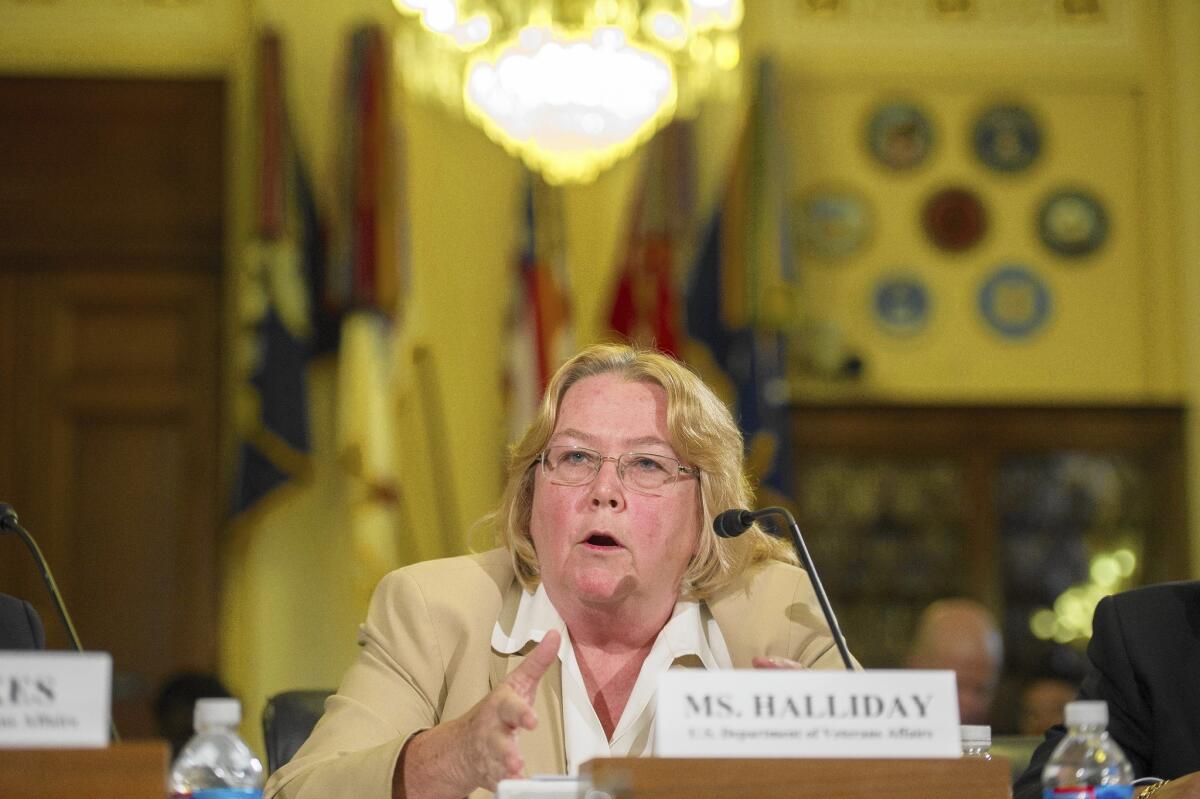VA overpaid $230 million in disability claims, official tells Congress

- Share via
The Department of Veterans Affairs’ disability system has improperly paid former service members at least $230 million over the last few years, according to the VA’s inspector general’s office.
The overpayments stem largely from the department’s attempts to clear a massive backlog of claims for disability compensation.
In trying to speed up the claims process, the VA made frequent errors and failed to reduce disability pay when necessary, Linda Halliday, an assistant inspector general, wrote in testimony given to Congress on Monday.
The department has not followed up on thousands of cases in which veterans were awarded temporary disability ratings of 100% and paid accordingly, Halliday wrote. Of 8,300 such cases, 7,400 had not been reviewed and given final ratings, including many that were more than a year old.
As a result, an estimated 3,100 veterans have received nearly $85 million since the beginning of 2012 without adequate medical evidence that they deserve the benefits, investigators found.
If the problem is not corrected, taxpayers will lose an additional $371 million over the next five years, Halliday said in testimony for the House Veterans Affairs Committee.
A disability rating of 100% entitles a veteran to about $3,000 a month, tax free.
“Improved financial stewardship at the agency is needed,” Halliday testified. “More attention is critical to minimize the financial risk of making inaccurate benefit payments.”
Investigators also found that the VA routinely neglected its responsibility to stop disability payments to military reservists while they were receiving “drill pay” for training exercises. It is not uncommon for service members to leave the military, begin receiving disability pay from the VA, then enter the reserves.
Federal law, however, requires cutting disability by the amount of drill pay.
Investigators estimated that the VA overpaid tens of thousands of reservists $48.9 million in disability pay in 2011 and $95.7 million in 2012. Not fixing the problem would cost an additional $478 million by 2017, auditors estimated.
VA officials told inspectors that “higher priorities, such as processing compensation claims, took precedence over processing offsets,” Halliday testified.
Distinct from the VA healthcare spending, the $49-billion-a-year disability system is essentially workers’ compensation for former service members. Any medical condition that occurs during military service, even if it is unrelated to military training or operations, qualifies for disability pay. The most common conditions are tinnitus, hearing loss, post-traumatic stress disorder, diabetes and joint problems.
The VA uses a formula that combines a veteran’s conditions into a rating of 0% to 100% — in 10% increments. The higher the rating, the larger the monthly disability check.
Veterans can apply for higher ratings if ailments grow worse.
For decades, the number of veterans on the disability rolls held relatively steady. But between 2001 and 2013, enrollment climbed from 2.3 million to 3.7 million, more than doubling the annual cost.
The growth was driven in roughly equal measure by Vietnam veterans and veterans of the recent wars. The government invited a massive influx of claims by expanding eligibility for a variety of ailments linked to Agent Orange exposure in Vietnam, loosening the requirements for post-traumatic stress disorder claims and streamlining the application process for service members as they returned to the civilian world.
The VA was unprepared for the surge in claims, and by early 2013, more than 600,000 veterans were waiting more than 125 days — and sometimes years — for disability ratings.
The backlog became an embarrassment for the government, which vowed to eliminate it by 2015.
The claims process was streamlined. The work was spread out to disability raters across the country who were ordered to work overtime. The backlog has now been reduced to 267,000.
The VA announced Monday that it had processed 1 million claims since last fall and was on target to reach 1.3 million by the end of fiscal 2014, more than it has ever processed in a single year.
But the inspector general’s office said the drop had come at the expense of other VA functions.
The number of veterans waiting for decisions on appeals has climbed from 227,609 in the fall of 2011 to more than 280,000 today. And an audit of a major VA office in Indianapolis found that the department was not processing incoming mail in a timely way or properly investigating allegations of misuse of funds meant for veterans.
Investigators are now looking at allegations that 40,000 pieces of mail, much of it related to claims, has been shredded or hidden at VA benefits offices in Philadelphia and Baltimore.
In response to the testimony from the inspector general, the VA issued a statement before the hearing saying that it had made significant process in transforming the way it did business.
“At the same time, we certainly have more work to do to achieve our goal,” it said.
Twitter @AlanZarembo
More to Read
Sign up for Essential California
The most important California stories and recommendations in your inbox every morning.
You may occasionally receive promotional content from the Los Angeles Times.










